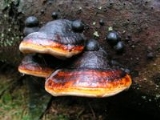
Fomitopsis pinicola
Encyclopedia
Fomitopsis pinicola, in English sometimes known as Red Banded Polypore, is a polypore
Polypore
Polypores are a group of tough, leathery poroid mushrooms similar to boletes, but typically lacking a distinct stalk. The technical distinction between the two types of mushrooms is that polypores do not have the spore-bearing tissue continuous along the entire underside of the mushroom. Many...
mushroom
Mushroom
A mushroom is the fleshy, spore-bearing fruiting body of a fungus, typically produced above ground on soil or on its food source. The standard for the name "mushroom" is the cultivated white button mushroom, Agaricus bisporus; hence the word "mushroom" is most often applied to those fungi that...
of the genus Fomitopsis
Fomitopsis
Fomitopsis is a genus of bracket fungi in the family Fomitopsidaceae.The name means having the appearance of fomes.-Species:*Fomitopsis cajanderi*Fomitopsis palustris*Fomitopsis pinicola*Fomitopsis rosea*Fomitopsis spraguei...
. The species
Species
In biology, a species is one of the basic units of biological classification and a taxonomic rank. A species is often defined as a group of organisms capable of interbreeding and producing fertile offspring. While in many cases this definition is adequate, more precise or differing measures are...
is common throughout the temperate
Temperate
In geography, temperate or tepid latitudes of the globe lie between the tropics and the polar circles. The changes in these regions between summer and winter are generally relatively moderate, rather than extreme hot or cold...
Northern hemisphere
Northern Hemisphere
The Northern Hemisphere is the half of a planet that is north of its equator—the word hemisphere literally means “half sphere”. It is also that half of the celestial sphere north of the celestial equator...
. An alternative binomial name is Fomes pinicola.
Characteristics
Cap hoof-shaped or triangular, hard and tough texture, up to 30-40 x 25 x 10 cm. Surface is more or less smooth, at first orange-yellow with a white margin, later dark reddish to brown and then frequently with orange margin. Pore surface pale yellow to leather-brown, 3-4 pores per mm. Grows on live and dead coniferous or (less common) deciduous trees.The fruiting body
Sporocarp (fungi)
In fungi, the sporocarp is a multicellular structure on which spore-producing structures, such as basidia or asci, are borne...
of Fomitopsis pinicola is called the conk. It is a woody, pileate
Pileus (mycology)
The pileus is the technical name for the cap, or cap-like part, of a basidiocarp or ascocarp that supports a spore-bearing surface, the hymenium. The hymenium may consist of lamellae, tubes, or teeth, on the underside of the pileus...
fruiting body with pores lined with basidia
Basidium
thumb|right|500px|Schematic showing a basidiomycete mushroom, gill structure, and spore-bearing basidia on the gill margins.A basidium is a microscopic, spore-producing structure found on the hymenophore of fruiting bodies of basidiomycete fungi. The presence of basidia is one of the main...
on its underside. As in other polypores, the fruiting body is perennial with a new layer of pores produced each year on the bottom of the old pores.
This mushroom is inedible due to its woody texture.

